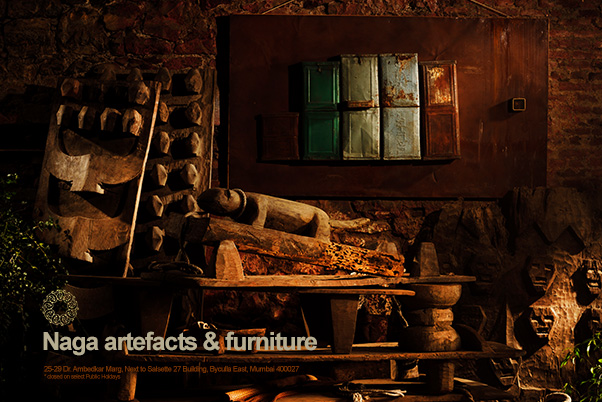The Nagas - Furniture and Artifacts
The Naga people spread across North-East India and parts of Burma have traditionally lived-in self-reliant village settlements and have thus mastered crafts such as wood working, weaving, metal-working etc to provide for everyday objects such as beds, mats, stools, wooden dishes etc. These are more than just decorative items or functional pieces—they’re a deep dive into the tribal traditions of the Naga people.What makes Naga furniture truly special is its minimalist approach. If you’ve ever seen a traditional Naga bed, stool or chair, you’ll notice that it’s often made from a single block of wood, carefully carved to create a sturdy and beautiful piece. The earlier furniture pieces were also often carved as the Nagas did not use nails to join different wooden pieces together. The simplicity and gravity of these pieces is palpable.
And it’s not just the furniture that’s captivating—the artifacts are just as fascinating. Naga artifacts, whether they are tools, weapons, or ritual items, are a huge part of the tribe’s identity. The Naga people were known as fierce warriors, and this is reflected in the artifacts they created. Spears, shields, and other traditional weaponry were not just tools for survival; they were also symbols of bravery and protection.
Another area where Naga craftsmanship shines is in their textile work. Naga shawls are famous for their bold, geometric patterns and vibrant colours. But these shawls aren’t just pretty to look at. They carry deep cultural significance, with different designs representing different tribes and statuses. For example, certain shawls were only worn by warriors or leaders, marking their achievements and rank in society. When you wrap yourself in one of these shawls, you’re not just wearing a piece of cloth—you’re wearing a piece of Naga history and pride.
Wood carvings are another signature of Naga artistry. From small figurines to larger, totem-like sculptures, these carvings often depict animals, ancestors, or deities that hold spiritual significance. In traditional Naga homes, these carved figures weren’t just decorative; they were believed to offer protection and connect the people to their ancestors. Placing one of these carvings in your home can bring a sense of cultural richness and history to any space. The wood carvings are often coloured in black, terracotta and white pigments derived from natural sources; they proclaimed the status and power of the house owner or the village itself.
Let’s not forget about the stunning beaded jewelry and ornaments. The Naga people are known for their colourful and intricate beadwork, which is used to make necklaces, armlets, and other accessories. These aren’t just fashion statements—they’re symbols of status, tribe, and identity. The beadwork is often made from stones, bones, and beads, with each piece telling a story about the person who wears it. These beautiful, handcrafted items are still a big part of Naga culture today, and owning one means carrying a piece of their heritage with you.
What’s amazing about Naga furniture and artifacts is that they seamlessly blend tradition with sustainability. The materials used, like bamboo and wood, are sourced locally and often in an environmentally conscious way. In today’s world of mass-produced, factory-made furniture, Naga pieces offer a refreshing alternative. They have character, history, and carry a story—something that’s hard to find in mainstream furniture.
The Great Eastern Home,
The New Great Eastern Spg. & Wvg. Mills Co. Ltd.,
25-29, Dr. Baba Saheb Ambedkar Road,
Next to Salsette 27 Building,
Byculla East, Mumbai 400027, India
+91 9137139126, +91 98691 64813
info@thegreateasternhome.com
